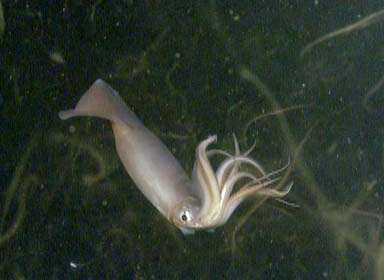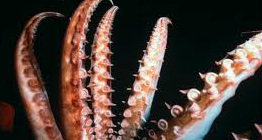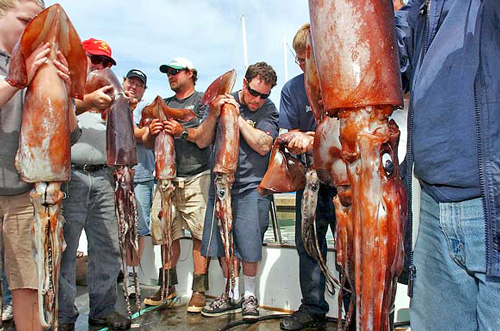(Dosidicus gigas)
The Humboldt Squid goes by many names. Mexican fishermen call it the diablo rojo (red devil), based on accounts of Humboldts that flash bright red when attacking their prey. They're also called Jumbo Flying Squid, because like other members of the family Ommastrephidae, they are volplaning organisms – they can eject themselves from the water and use their fins to glide at a height of up to 6 meters above the surface of the water. Their traditional common name comes from the Humboldt Current, a cold, low-salinity, nutrient-rich upwelling system off South America's western coasts, where 18-20% of the world's fish catch comes from and where Humboldts are known to live.
Humboldts are sexually dimorphic; the female is larger than the male, a relative rarity in the animal kingdom. Although no courtship ritual has been observed, based on their intelligence and social complexity and observing behaviors in similar species, it's likely some form of courtship occurs. At maturity, one of the males' ventral arms develops into a spermatophore-carrying hectocotylus that fertilizes a mass of 2 million eggs. The parents do not invest in the offspring after fertilization, dying soon after. Humboldts grow to a length of 6-7 ft. and a weight of around 100 lbs. (they are the 4-5th-largest squid species by mass). They mature quickly and only live 1-2 years. Like all squids, they never develop any bone structure, relying on the fluid within their body cavities to support their shape (a hydrostatic skeleton), as well as their 1-metre chitinous gladius (pen).
Humboldts participate in diel vertical migration (DVL), swimming to shallower waters at night to hunt and returning to deep water at dawn. There is more potential prey available in the euphotic zone, and spending the nights in warmer shallower waters allows the Humboldt and other DVL organisms to conserve energy and heat. DVL is central to the biogeochemical process known as the oceanic carbon pump, the ongoing entrance of carbon into seawater as soluble HCO3 ions, its fixation by photosynthetic organisms and its transport to the ocean floor in the form of biomass or as carbon compounds like CaCO3. Most of this transport occurs as detritus (or "marine snow") sinking down into deep waters, but DVL organisms speed up the process by feeding on euphotic life and actively moving biomass-trapped carbon down to the deep, releasing in their waste or remains. The carbon pump is a major part of the global carbon cycle and essential to regulating atmospheric greenhouse gases; it is estimated that one-third of anthropogenic carbon emission are taken up by the ocean through the carbon pump.
Learn more about the Humboldt Squid:
- http://www.outsideonline.com/outdoor-adventure/science/It-s-Hard-Out-Here-for-a-Shrimp.html?page=all
- http://www.bioweb.uwlax.edu/bio203/s2012/bonis_alis/index.htm
- http://nationalzoo.si.edu/animals/invertebrates/facts/cephalopods/factsheets/humboldtsquid.cfm
- http://www.pbs.org/wnet/nature/episodes/encountering-sea-monsters/video-humboldt-squid-makes-contact/1032/
- the Chambered Nautilus, a living fossil that that has survived pretty much unchanged for the past 500 million years
- The Colossal Squid, a reclusive Antarctic deep-sea dweller with the largest body mass of any cephalopod
- The Greater Blue-Ringed Octopus, a small but dangerous octopus equipped with neurotoxins that can kill humans
- The Veined Octopus, a tool-using, bipedal cephalopod (think Animal Farm pigs, but cuter)





 RSS Feed
RSS Feed
